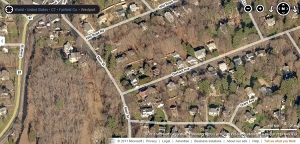Gorham Avenue Historic District
- District Overview
- Inventory List
- Town:
- Westport »
- Year of Establishment:
- 2006
- Notes on Establishment:
- The original district established in 2006 was later expanded in 2007 to include more properties along Wild Rose Road and the Lee Canal.
- Overlapping Historic Designation(s):
- LHD, SR
- District Authority:
- Westport Historic District Commission
- Link to Commission or Municipal Website:
- Map:
-
Map of the historic district retrieved from the Historic District Commission Handbook.
View photo - District Character:
- Suburban Neighborhood
- Features:
Buildings, Others- Canal
- Architectural Style:
18th Century, 19th Century, 20th Century
- Era:
- Arts and Crafts Revival, Colonial Revival, Vernacular Arts and Crafts, Italianate
- General description:
Soon after the Revolutionary war, the Town of Fairfield began to have secessionist movement for self-governance within its outlying villages. Spearheaded by a resident named Daniel Nash, 130 villages made an application to the Connecticut General Assembly to incorporate as a town. In the process, Westport incorporated parts of Weston, Norwalk and Fairfield. Because of the economic influence of the villages, which at the time were specializes in onion farming and coastal shipping, the charter was granted on May 28, 1935. On the long lots were laid out at the beginning of the 18th century, several families settles the area immediately north of the village of Westport. The Gorham, Beers and the Coley families all owned land with frontage on main Street from the early 1700s through the first decades of the 20th century. [2]
- Significance of the district:
Gorham Avenue Historic district is a distinct collection of residential buildings designed to work in unison with one another, creating a uniform, but not homogenous environment. The time periods represented range from the Colonial era through the late 1930s. While only a few of the buildings from the 18th and 19th century remain the designs of the Eclectic periods historicist revival homes stand in harmony with their predecessors. All of the late 19th and early 20th century homes are modest in scale and reflect American architectural trends of the period. These range from the Arts and Crafts Bungalows, to a modest Prairie influence through the varied vernacular and standard Colonial Revival homes that make up the historic character of the streetscape. The minimal changes that have occurred over time have not obscured the period of interpretation and integrity of the neighborhood. [2]
- District Boundary (according to the LHD Study Report, copied in 2010):
The original district includes the premises shown as lots 119 through 131; lot 161 C and lots 164 through 174 on the map on file in the Town Clerk's office as Map No. 9757. The boundaries were further extended in 2007 to include more properties and Lee Canal as described in the ordinance.
- Sources:
[1] District information retrieved from the town website http://www.westportct.gov/.[2] Study report for the proposed Gorham Avenue historic district, 2006, SHPO Library, Hartford. [3] Westport Historic Resource Inventories accessed from the town website [http://www.westportct.gov/modules/showdocument.aspx?documentid=910].[4] Historic District handbook accessed in the town website [http://www.westportct.gov/modules/showdocument.aspx?documentid=280].[5] Assessor information retrieved from the website- www.visionappraisal.com.[6] GIS information retrieved from http://webmap.jws.com/taxmap/viewer.aspx?JWSCONFIG=CT_Westport.
- Notes:
None
- Disclaimer:
Content for this website and district boundaries were compiled from several sources and are subject to change. Boundaries for LHDs may be different from those of State or National Register Districts. To verify the boundaries and particulars of a specific district, consult the LHD study report on file with the respective municipal authority or the State Historic Preservation Office.
- Date of Compilation:
- 12/31/11
- Compiler:
- Manjusha Patnaik, CT Trust for Historic Preservation
